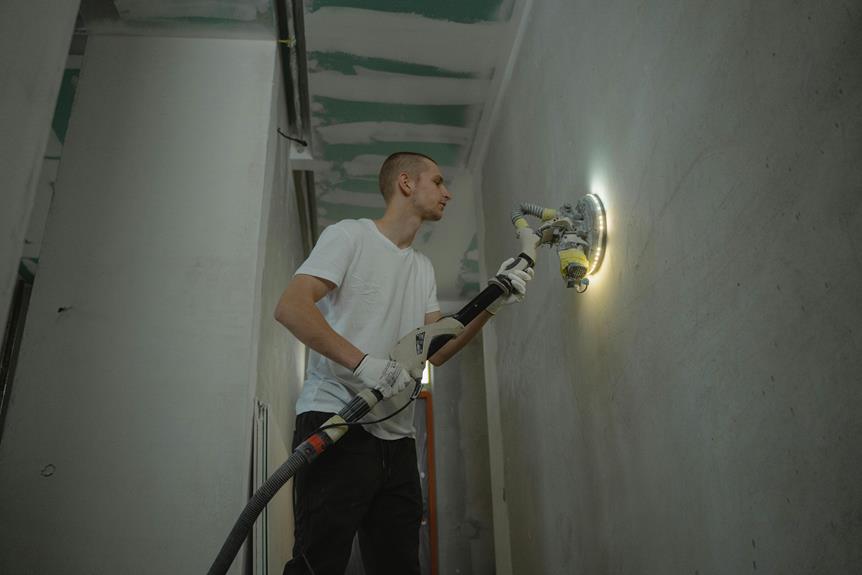Sound-Proofing Secrets Revealed
Effective soundproofing requires a thorough understanding of noise sources and transmission, as well as strategic implementation of noise-reducing materials and techniques. By decoupling ceilings from floor joists, adding mass to absorb sound waves, and sealing gaps and cracks, you can substantially reduce noise transmission. Proper installation and maintenance of acoustic ceiling tiles are also vital for peak results. With various design options available, including different patterns, finishes, and edge styles, acoustic ceiling tiles can enhance aesthetic appeal while improving sound quality. As you explore these soundproofing strategies, you'll discover how to create a more peaceful and productive environment that meets your unique needs.
Effective Soundproofing Strategies
A well-designed soundproofing plan is crucial to minimizing unwanted noise and creating a more comfortable living or working space.
Effective soundproofing strategies involve understanding the sources of noise and how it travels. Noise can enter through walls, floors, and ceilings, making it essential to address these areas.
One key approach is to decouple the ceiling from the floor joists using resilient channels, which reduce the transmission of noise. Another strategy is to add mass to the ceiling, such as acoustic ceiling tiles, to absorb sound waves.
Additionally, sealing gaps and cracks around doors, windows, and electrical outlets can help prevent noise from escaping or entering. By implementing these strategies, individuals can create a more peaceful and productive environment.
Ceiling Tile Installation Essentials
When it comes to ceiling tile installation, proper planning and execution are crucial to achieving a successful outcome.
Two installation methods are available: gluing directly to a wallboard or plaster ceiling, or attaching to wood furring strips with staples. For a quick and simple method, use adhesive; for a more complicated installation, use furring strips.
Before applying adhesive, clean the ceiling thoroughly to guarantee bonding. Apply adhesive to the tile back or ceiling using a notched trowel and press the tile firmly into place.
For furring strips, install them on 12-inch centers perpendicular to the ceiling joists and attach with screws. By following these essentials, you'll achieve a professional-looking ceiling that enhances your space's aesthetic and functionality.
Maintaining Acoustic Ceiling Systems
Every acoustic ceiling system requires regular maintenance to preserve its appearance and sound-absorbing properties.
Neglecting maintenance can lead to a decline in the ceiling's performance and aesthetic appeal.
To keep your acoustic ceiling system in top condition, follow these essential maintenance tips:
- Seal stains with a shellac primer-sealer or stain sealer and touch up with regular paint.
- Vacuum the ceiling periodically with an upholstery attachment to remove dust and dirt.
- Apply thinned latex paint to brighten a dingy ceiling.
- Replace unsalvageable tiles by cutting around the damaged tile, prying it off, and scraping off old adhesive.
Design Options for Acoustic Tiles
One of the primary benefits of acoustic ceiling tiles is their versatility in design, offering a wide range of patterns, finishes, and edge styles to suit various spaces and decors.
From modern and minimalist to natural and elegant, acoustic ceiling tiles come in various patterns, such as fissured, perforated, and textured. Plain white tiles provide a clean look, while stone and wood-look tiles offer a natural appearance.
Metallic finishes add a touch of sophistication, and different edge styles, including reveal, tegular, and lay-in edges, change the overall appearance of the installed tiles.
This versatility allows homeowners to choose the perfect design to match their unique style and decor, liberating them from the constraints of traditional ceiling designs.
Benefits of Acoustic Ceiling Solutions
Acoustic ceiling tiles offer a multitude of benefits that make them an attractive option for homeowners and commercial property owners alike.
They provide a simple and cost-effective way to improve the aesthetic appeal of a room while also enhancing its acoustic properties.
- Improved Aesthetics: Acoustic ceiling tiles come in a variety of styles and finishes, allowing homeowners to match their design with their desired decor.
- Easy Installation: Acoustic ceiling tiles are a DIY-friendly project that can be installed quickly and easily, making them an ideal solution for those looking to update their space.
- Cost-Effective: Acoustic ceiling tiles are a low-cost solution compared to other sound-proofing methods, making them an attractive option for those on a budget.
- Enhanced Acoustics: Acoustic ceiling tiles are designed to reduce echo and improve sound quality, making them an ideal solution for home theaters, recording studios, and other sound-sensitive spaces.
Essential Acoustic Ceiling Facts
Since acoustic ceiling tiles have become a popular choice for homeowners and commercial property owners, understanding the fundamental facts about them is crucial for making informed decisions.
Acoustic ceiling tiles come in various patterns and finishes, such as fissured, perforated, and textured, offering a range of design options.
They are available in different edge styles, including reveal, tegular, and lay-in edges, which can alter the overall appearance of the installed tiles.
Most tiles are half an inch thick, with thicker options available, and typically range from $0.75 to $3 per square foot.
Insulation should be installed above acoustic ceiling tiles to reduce heat loss and dampen noise, and they can be painted with thinned latex paint.
Soundproofing With Acoustic Tiles
Effective soundproofing is a crucial aspect of creating a comfortable and distraction-free environment.
Acoustic ceiling tiles play a significant role in achieving this goal. They are a simple and cost-effective solution to minimize echo and reverberation, creating a more peaceful atmosphere.
- Improved Sound Absorption: Acoustic ceiling tiles are designed to absorb sound waves, reducing echo and reverberation.
- Enhanced Aesthetics: Available in various patterns, finishes, and edge styles, acoustic ceiling tiles can enhance the visual appeal of a room.
- Easy Installation: Acoustic ceiling tiles can be installed using a simple adhesive or furring strips, making them a DIY-friendly option.
- Cost-Effective: Compared to other soundproofing materials, acoustic ceiling tiles are a budget-friendly solution for improving sound quality.
Frequently Asked Questions
Can Acoustic Ceiling Tiles Be Used in Humid or Wet Areas Like Bathrooms?
When considering acoustic ceiling tiles in humid or wet areas like bathrooms, it's vital to select tiles with moisture-resistant properties, such as those with specialized coatings or water-resistant materials, to guarantee durability and performance.
Do Acoustic Ceiling Tiles Contain Asbestos or Other Hazardous Materials?
Modern acoustic ceiling tiles are asbestos-free and non-toxic, made from materials like mineral fiber, fiberglass, or recycled content, ensuring a safe and healthy environment; however, older tiles may contain hazardous materials, so crucial to identify their composition before installation or renovation.
Can I Install Acoustic Ceiling Tiles Over Radiant Heating Systems?
When installing acoustic ceiling tiles over radiant heating systems, guarantee the tiles are designed for high-temperature environments and follow the manufacturer's guidelines to prevent damage or compromised performance.
Are Acoustic Ceiling Tiles Suitable for Use in Outdoor or Exterior Applications?
Acoustic ceiling tiles are not suitable for outdoor or exterior applications due to their sensitivity to moisture, UV exposure, and extreme temperatures, which can compromise their structural integrity and sound-absorbing properties.
Can Acoustic Ceiling Tiles Be Recycled or Reused After Removal?
Acoustic ceiling tiles can be recycled or reused after removal, depending on their condition and material composition, offering an eco-friendly solution for environmentally conscious individuals and businesses seeking sustainable renovation practices.



